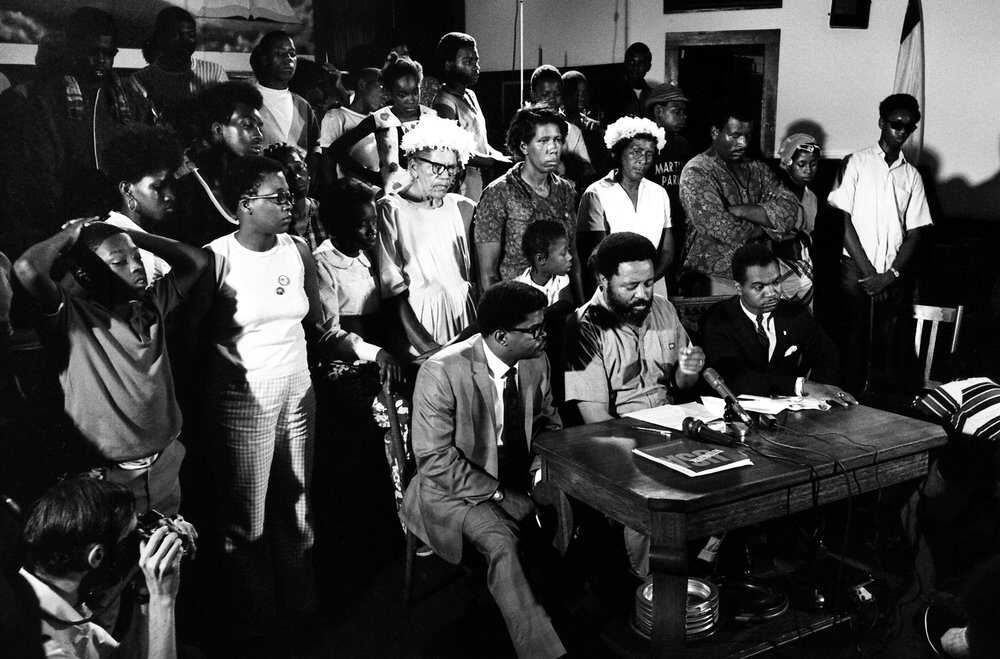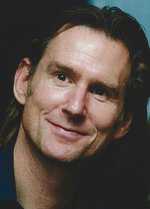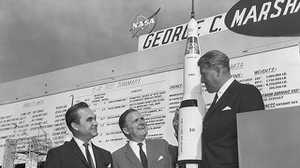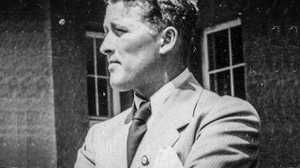Raised Fists and Lunar Rockets
Black activists demanded the resources for space be brought back to earth.
By Neil M. Maher

Excerpted from Apollo in the Age of Aquarius, by Neil M. Maher, published by Harvard University Press.
While residents of Los Angeles, Detroit, Newark, and hundreds of other cities across America took to the streets to protest polluted and unhealthy living conditions in America’s cities, and perhaps NASA’s role in exacerbating them, less militant civil rights leaders such as Ralph Abernathy began consciously employing tried-and-true civil rights strategies used during the 1950s and early 1960s to publicly critique the space race in the late 1960s. For instance, even before Abernathy’s Poor People’s Campaign had packed up their mules and left Cape Canaveral, other civil rights leaders had organized a sit-in not at a Woolworth’s counter in Greensboro, North Carolina, but rather underneath a full-size mock-up of the Apollo lunar landing module in Houston, Texas. Orchestrated by the National Welfare Rights Organization, a civil rights group created in 1966 to advocate on behalf of welfare recipients, the sit-in took place just outside NASA’s Mission Control, at what was then known as the Manned Spacecraft Center. The protest involved seventy-five African American protestors waving signs demanding a halt to future moon missions until the federal government began cleaning up cities and providing for affordable and healthy urban housing. The following year more than a dozen civil rights protesters returned to Houston to demonstrate once again under the same model of the lunar lander, where President Richard Nixon was presenting the Medal of Freedom to NASA’s flight control team for rescuing the Apollo 13 astronauts. As sheriff’s officers escorted the protesters away from the ceremony site, newspaper reporters covering the event noted that the demonstrators raised their fists in a black power salute.
Along with sitting in, civil rights activists also took to their feet and organized marches to highlight the discrepancy between federal funds spent on America’s space effort versus those used to better the urban environment. In a protest intended to mirror the Selma-to-Montgomery demonstrations of 1965, civil rights activists from the SCLC and the Daytona Beach Citizens Coordinating Committee organized a three-day, seventy- five-mile “March against Moon Rocks” from Daytona Beach, Florida, to Cape Canaveral to coincide with the January 31, 1971, Apollo 14 launch. Among the 200 protesters were thirty black maids from Daytona who earned $35 a week cleaning $50-a-day hotel rooms. Marchers held rallies along the route, stayed overnight in the homes of local black citizens, and ended the march with a prayer service in the town of Titusville near the launch site. “Our country is spending $30 billion,” explained one march organizer, “to get some moon rocks for Vice President Spiro Agnew to hand out to heads of state.” Another participant couched this practice of gifting moon rocks to foreign countries in order to curry diplomatic favor, which President Nixon initiated, in less diplomatic terms. “America is sending lazy white boys to the moon because all they’re doing is looking for moon rocks,” he complained. “If there were work to be done, they’d send a n-----.” At the end of their march, the protestors demanded that federal dollars instead be redirected from exploring outer space to helping “the plight of the working poor” in cities back on Earth.
Following a long tradition, civil rights leaders also organized boycotts to protest against the space race and to raise awareness of urban poverty and environmental degradation in minority neighborhoods. Instead of boycotting buses in Montgomery, however, former SNCC chairman and future Washington, DC, mayor Marion Barry used his position as a co-founder of Pride, Inc., a program that retrained unemployed black men in the nation’s capital, to encourage the country’s black community to ignore President Nixon’s National Day of Participation. The proclaimed federal holiday on July 21, 1969, gave federal employees the day off, and it encouraged the private sector and the nation’s schools to do the same, so that as many Americans as possible could celebrate Neil Armstrong’s and Buzz Aldrin’s moonwalk. “Why should blacks rejoice when two white Americans land on the moon, when white America’s money and technology have not yet even reached the inner city?” asked Barry at a press conference in the heart of Washington’s ghetto. “Why should blacks celebrate Monday as a national holiday when President Nixon didn’t feel that Dr. Martin Luther King’s assassination deserved to be observed?” While boycotting the civic holiday, Barry argued, African Americans should volunteer their time with community groups aiding in the environmental cleanup and financial rejuvenation of their own urban neighborhoods.
More informal boycotts took place as well. On the day of the Apollo 11 moon landing, for example, black patrons at the Metropole Bar on the corner of Twenty-Third Street and Michigan Avenue in Chicago tuned the television instead to a local baseball game. In New York, 50,000 mostly African American music lovers flocked to the Harlem Cultural Festival, where the announcement of the lunar touchdown brought forth a chorus of boos from the audience. The following day, when the New Yorker dispersed reporters throughout the city to record people’s reactions to the Apollo 11 moonwalk, they also found residents in Harlem disinterested if not openly hostile. Inside the Lincoln Bar, at the corner of Lenox Avenue and 135th Street, explained the magazine’s “Talk of the Town” feature, “scarcely anyone was looking or listening to the television coverage when Armstrong placed his foot on the moon.” “There ain’t no brothers in the program,” explained an African American bar patron, who added that he was rooting for the “Mets over the Moon.” “The whole thing uses money that should be spent right here” in the ghetto, he added. Three days after splashdown the New York Times reported similar findings, concluding that “many black Americans found ways in recent days to ignore the Apollo 11 moon shot, an effort, they say, that ignored them.”
Finally, in yet another attempt to draw national attention to deplorable living conditions in the nation’s cities, civil rights leaders also organized numerous acts of nonviolent civil disobedience during the public celebrations for returning Apollo astronauts. On the West Coast such demonstrations began soon after Armstrong, Aldrin, and Collins had returned safely to Earth. On August 13, 1969, several hundred activists participated in a boisterous rally organized by the SCLC and other civil rights groups at Los Angeles’s Century Plaza Hotel, where President Nixon was bestowing the Medal of Freedom on the three Apollo astronauts at a lavish state dinner. The guest list of more than 1,500 included forty-four of the fifty state governors, diplomats from eighty-five nations, several Supreme Court Justices, Hollywood actors and comedians, and Charles Lindbergh. While diners sipped champagne inside the hotel’s grand ballroom, the demonstrators outside in the parking lot dipped defiantly in the Century Plaza’s fountain and distributed leaflets declaring that although Americans “have moved forward in space we have repeatedly lagged behind in areas of civil rights” such as poverty, hunger, and “intolerable ghetto conditions.” When the dinner ended, reported the New York Times, and “the tuxedos and sequins rolled past in their long cars,” civil rights protesters again “silently raised their fists.”
The most elaborate of such nonviolent demonstrations occurred on March 8, 1971, during New York City’s ticker-tape parade for Apollo 14. After leaving their hotel, the St. Regis, at noon in a sixteen-car caravan flanked by twenty-four police motorcycles blaring their sirens, astronauts Alan Shepard, Edgar Mitchell, and Stuart Roosa waved to millions gathered along Fifth Avenue from their convertible under a shower of confetti. When the parade reached Broadway and West Third Street, however, the party was abruptly interrupted. There, outside the Broadway Central Hotel, which housed 300 welfare families, twenty African American protestors blocked traffic by pushing baby strollers into the street and waving signs reading “White Astronauts Fly to the Moon While Black Children Die in Welfare Hotels.” Although police officers soon cleared the motorcade route, an hour later at City Hall when Mayor John Lindsay presented the city’s Gold Medal to the Apollo 14 astronauts, the hotel’s residents resumed the demonstration by waving additional placards reading “Welfare Hotels—The New-Style Concentration Camps.” Although Lindsay broke from his prepared remarks to suggest that the technology used to transport Apollo 14 to the moon “can also help to bring our cities back,” the protestors remained unconvinced. The activists’ continual chant of “crumbs for the children and millions for the moon,” reported the New York Times, “provided a steady obbligato to the prayers and speeches” in honor of the astronauts.

Neil M. Maher is a history professor at the New Jersey Institute of Technology and Rutgers University at Newark, where he teaches environmental and political history. He has written about the Johnson Space Center’s beauty pageant in his most recent, award-winning book, Apollo in the Age of Aquarius (Harvard University Press, 2017).
Copyright © 2017 by the President and Fellows of Harvard University College. Used by permission. All Rights Reserved.







